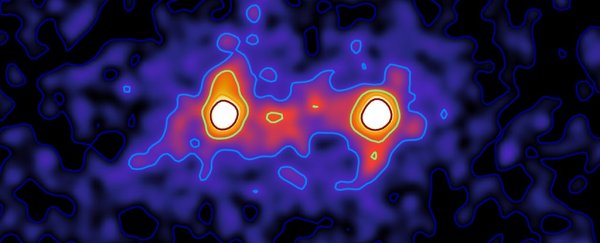Picture the Universe, and you might imagine a dark emptiness speckled with maybe trillions of galaxies, each containing many billions of stars.
The truth is a little weirder, with apparently separate galaxies connected into vast intergalactic webs by invisible filaments of dark matter. If you find it hard to imagine, at least now we can actually see some of those threads thanks to some clever use of gravitational lensing.
A team of astronomers at the University of Waterloo in Canada used the space-bending effects of dark-matter to see the unseeable, combining catalogues of galaxy groups that act as lenses with catalogues of data on the light-sources behind them to create a visual of their 'dark' features.
First, a refresher on dark matter: use some form of telescope, and what you can detect directly makes up just five percent of the observable Universe.
Another 68 percent – if it exists – is some sort of energy that pushes space apart at ever faster speeds. Since so little else is known about this force (and we can't see physicists shrug as they write about it), the cause is referred to as ' dark energy'.
Dark matter is different. It makes up about 27 percent of the observable Universe; and like dark energy, we can see an effect without knowing much about what seems to be causing it.
That effect is basically gravity – but while most materials that have mass also seem to either emit or absorb electromagnetic radiation or at least interact with nuclear forces, clumps of dark matter sit silently, making a bit of a dent in the surrounding fabric of the Universe but not responding to anything else.
So far we've been able to gauge roughly where these blobs of dark matter might be by mapping stars and galaxies and determining how much more mass there should be to account for their movements and positions.
That's told us that regular old bright matter and its dark cousin tend to come together to form clumps, with the more prevalent dark matter forming 'halos' around the glowing gas, stars, and shadowy clouds of dust.
We've also known for some time that dark matter doesn't just settle into vast cosmic puddles, but that it looks more like clumpy strings of taffy pulled apart into webs by the stretching of the Universe.
That also means galaxies tend to settle along these threads, forming interconnected superclusters that stretch out in maps not just of space, but of time itself.
Knowing dark matter lies between visible galaxies on the cosmic web is one thing – actually seeing it is something else.
"For decades, researchers have been predicting the existence of dark-matter filaments between galaxies that act like a web-like superstructure connecting galaxies together," said researcher Mike Hudson.
"This image moves us beyond predictions to something we can see and measure."
As starlight passes through a mass, such as a galaxy, the light drifts with the curves and dimples caused by the warping effects of gravity.
By combining various images of 23,000 pairs of galaxies about 4.5 billion light-years away, the astronomers were able to use slight variations to build a relatively detailed map of the bridges of otherwise invisible dark matter connecting them.
Not only is it just pretty to look at, it reveals some interesting features which would otherwise be difficult to detect.
"By using this technique, we're not only able to see that these dark matter filaments in the universe exist, we're able to see the extent to which these filaments connect galaxies together," said Epps.
For example, the threads of dark matter appear to be strongest between clusters of galaxies less than 40 million light-years apart.
Adding this resolution to existing maps could reveal a few more tantalising details about this mysterious form of matter, or tell us more about how the Universe evolved.
Or it'll just make us picture the Universe as a cosmic ball of sugar-speckled cotton candy from now on.
This research was published in Monthly Notices of the Royal Astronomical Society.
